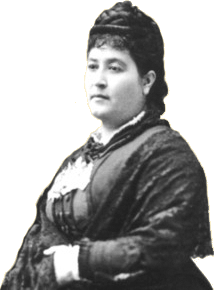At California Legacy, we're taking the plunge anyway, launching "What Do I Read Next?" occasional advice from the California Legacy Project about great—and not always well-known—writing about the Golden State.
The Squatter and the Don - María Amparo Ruiz de Burton
 In 1885, María Amparo Ruiz de Burton published The Squatter and the Don, a fictional but loosely autobiographical historical romance chronicling the tumultuous years in California as transitioned from Mexican control to American statehood. Writing under the pseudonym "C. Loyal" for "loyal citizen," Ruiz de Burton's The Squatter and the Don is one of the first fictional narratives written and published in English from the perspective of the newly marginalized Californios. Outraged over unfair land laws and the rise of corporate monopolies forcing the Californios to change their way of life, Ruiz de Burton crafted her story into a kind of call to arms and used an interethnic romance between a don's daughter and a white squatter's son to tell her story.
In 1885, María Amparo Ruiz de Burton published The Squatter and the Don, a fictional but loosely autobiographical historical romance chronicling the tumultuous years in California as transitioned from Mexican control to American statehood. Writing under the pseudonym "C. Loyal" for "loyal citizen," Ruiz de Burton's The Squatter and the Don is one of the first fictional narratives written and published in English from the perspective of the newly marginalized Californios. Outraged over unfair land laws and the rise of corporate monopolies forcing the Californios to change their way of life, Ruiz de Burton crafted her story into a kind of call to arms and used an interethnic romance between a don's daughter and a white squatter's son to tell her story.
 Just as Ruiz de Burton fought for her ranch against American capitalists who were eager for land, power, and money in the aftermath of the Treaty of Guadalupe-Hidalgo (1848), so too do the fictional Alamars fall victim to unfair land laws: "By the treaty of Guadalupe Hidalgo the American nation pledged its honor to respect our land titles just the same as Mexicans would have done," notes Don Mariano, the head of the Alamar family. "Unfortunately, however, the discovery of gold brought to California the riff-raff of the world, and with it a horde of land-sharks, all possessing the privilege of voting, and most of them coveting our lands…." The United States government will not protect them; instead, it passed more unfair land laws that favored the squatters. Things only become more complicated for the Alamars when the Darrells, a white squatter family, arrive to stake their claim on the Alamar ranch. Their son Clarence falls in love with Don Mariano's daughter Mercedes, and the two eventually marry. However, it is not entirely a happy ending because the Californios know that their way of life is coming to an end. As critics Rosaura Sanchez and Beatrice Pita note, "By the novel's end, the victims are seen to be not only the Californios and their immediate antagonists, the squatters, but also the city of San Diego and, in the long run, the entire state population—the 'white slaves of California'—who suffer the consequences of the collusion of state government, Congress and monopoly capitalism."
Just as Ruiz de Burton fought for her ranch against American capitalists who were eager for land, power, and money in the aftermath of the Treaty of Guadalupe-Hidalgo (1848), so too do the fictional Alamars fall victim to unfair land laws: "By the treaty of Guadalupe Hidalgo the American nation pledged its honor to respect our land titles just the same as Mexicans would have done," notes Don Mariano, the head of the Alamar family. "Unfortunately, however, the discovery of gold brought to California the riff-raff of the world, and with it a horde of land-sharks, all possessing the privilege of voting, and most of them coveting our lands…." The United States government will not protect them; instead, it passed more unfair land laws that favored the squatters. Things only become more complicated for the Alamars when the Darrells, a white squatter family, arrive to stake their claim on the Alamar ranch. Their son Clarence falls in love with Don Mariano's daughter Mercedes, and the two eventually marry. However, it is not entirely a happy ending because the Californios know that their way of life is coming to an end. As critics Rosaura Sanchez and Beatrice Pita note, "By the novel's end, the victims are seen to be not only the Californios and their immediate antagonists, the squatters, but also the city of San Diego and, in the long run, the entire state population—the 'white slaves of California'—who suffer the consequences of the collusion of state government, Congress and monopoly capitalism."
In addition to The Squatter and the Don's landmark contributions to Chicana literature, Ruiz de Burton's themes of resistance and cultural accommodation still resonate with today's readers. Her challenge to fight oppression in the state is as relevant today as it ever was, and the solutions she comes to are still worth thinking about.
The Squatter and the Don is available from Project Gutenberg.
A revised edition with an introduction by Rosaura Sanchez and Beatrice Pita from Arte Publico Press.
Want more?
Listen to "The Maid of Monterey," a song composed by J. H. Hewitt that was supposedly inspired by María Amparo Ruiz de Burton.
Sources:
Kathleen Crawford, "Maria Amparo Ruiz Burton: The General's Lady," The Journal of San Diego History, 30, no. 3 (1984): n. pag. Web. http://www.sandiegohistory.org/journal/84summer/burton.htm 8 Oct. 2012.
Lázaro Lima. The Latino Body: Crisis Identities in American Literary Cultural Memory. New York: New York University Press, 2007.
Vincent Pérez. Remembering the Hacienda: History and Memory in the Mexican American Southwest. College Station, Texas: Texas A and M University Press, 2006.
—Emily Elrod











